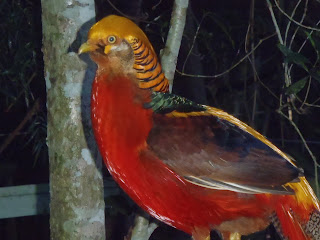Just next door to Monkeyland was the Birds of Eden Sanctuary. It is the largest single free flight sanctuary in the world. It is a 2+ hectare dome of netting set above a deep gorge. Previously caged birds from all over the globe live there in free flight and South African's who own birds that have been caged can apply to have their birds accepted into residence after a quarantine period.
We did not take a guided tour here, just followed the path and explored an unbelievable variety of avian wildlife in a glorious forest setting. We purchased the guidebook with the species of birds and ducks and other creatures living in the sanctuary.
As it was with Monkeyland many of the birds that we saw were not native to South Africa. Still it did not take away, at all, from the reality that we saw more different species and varieties of birds and ducks in 2 1/2 hours than we could ever see in a lifetime of travel.
When we entered the sanctuary we were told to hide anything shiny and I was advised to take off my earrings and turn around my wedding ring. Apparently, birds like shiny things as much as DD.
The path started at the top of the gorge and wound it's way down in lazy curves with benches to rest on and feeding stations for observation.
Now, in Ontario we have some beautiful birds: cardinals, blue jays, purple martins, orioles, gold finches. Never had we seen anything like we did at Birds of Eden.
The first bird we saw was a Golden Pheasant, native to Central Asia. The photo does not do it's plumage justice at all.
There were of course less colourful, but no less remarkable birds, like this grey lourie or go away bird from South Africa.
Still, colours were the main show at the Birds of Eden. Especially on birds like this Dusky Lory from New Guinea.
Or the Jandaya Conure from Brazil.
Even if we hadn't seen all these amazing birds the setting itself was breathtaking.
The sanctuary has done a wonderful job creating so many different types of environments in one space. There is an artificial mist on the suspension bridge that creates a humid rain forest effect below the clouds, there is a shallow pond for the wading birds and a deeper one for the swimmers. There was the plain old everyday indigenous forest and a waterfall that you could walk behind. All of this in 1.2 km pathway and every meter held a new surprise or bird to photograph.
Next Post - Birds of Eden - Part Two





No comments:
Post a Comment